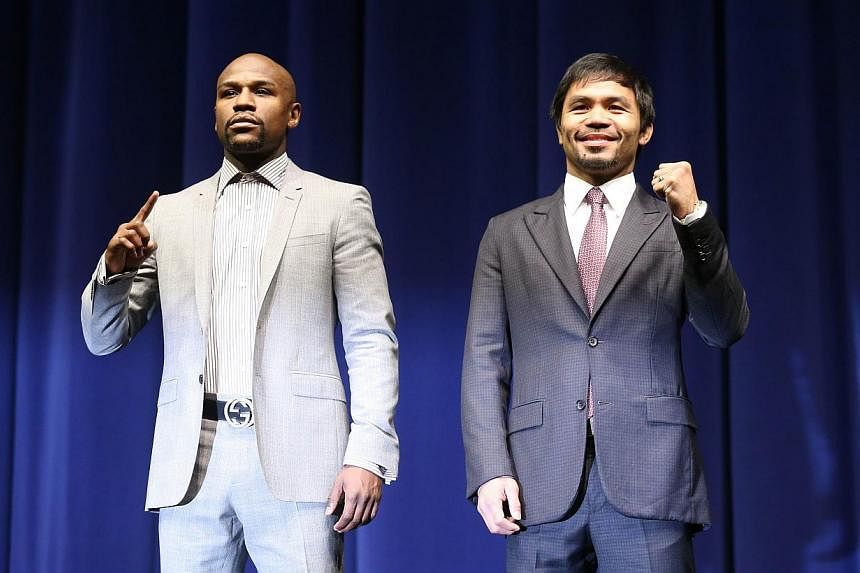The real Mayweather-Pacquiao fight? That's not tomorrow. That's over. Done. Dusted. History. There was plenty of ducking, weaving, feinting. Exploratory jabs, body blows and hooks. Lots of clinches but no surrender. But no, the protagonists were not Floyd Mayweather and Manny Pacquiao.
Instead, it was just their respective managers and representatives, in discussion with each other and with television networks and promoters. Arguing about money. No, make that fighting over money.
What happens tomorrow at the MGM Grand is the end game, the 12-round fight for the title. In contrast, it took roughly six years to set it all up - the protracted, often bitter wrangle to nail down a mutually-accepted dollar figure.
The longer it took to debate terms for this fight, the higher the monetary expectations on both sides and consequently, the greater the demand for the bout between two boxers whose best days, many experts say, are arguably behind them.
But there is another important consideration if the Mayweather-Pacquiao fight is to be seen not just in the context of history, but also in contemporary terms of its appeal and its PR value for boxing.
Despite history's great welterweight boxers - Sugar Ray Leonard, Jose Napoles, Joe Walcott, Sugar Ray Robinson, to name just a few - the heavyweight division has traditionally been the international standard-bearer for boxing.
Yet consider this. When was the last time a world heavyweight title fight and a world welterweight title fight were held within about a week of each other and the latter has not only grabbed most of the international attention, and also carried the richest purse in the history of the sport?
Last weekend, Wladimir Klitschko beat Bryant Jennings to retain his heavyweight championship belts at Madison Square Garden in New York, but neither fighter got anywhere near the exposure nor the money that Mayweather and Pacquiao are getting for a lower weight division.
Because abbreviations, like fight purses, are big in boxing, there are several acronyms that are relevant for tomorrow's fight. Among them are IRS, WBO, WBC, WBA, TMT, TBE, SHO, HBO and PPV - more letters, it seems, than the GPO.
The IRS is the United States' Internal Revenue Service, which will slug both fighters for its share of their pay packets. The next three are the organisations whose titles are up for grabs in this fight - the World Boxing Organisation, World Boxing Council and World Boxing Association.
The next two relate directly to Mayweather and his lucrative marketing strategy. TMT is the American boxer's lifestyle brand, The Money Team - which Pacquiao suggests, tongue in cheek, actually stands for The Manny Team. And TBE reflects the recent assertion by Mayweather that his undefeated 47-0 record makes him The Best Ever.
SHO and HBO are, respectively, Showtime and Home Box Office, the two major US cable and satellite TV networks that are boxing's financial lifeline. Pacquiao is contracted to HBO, which covers most of boxing's big-ticket fights, while Mayweather, the world's richest athlete, signed a six-fight deal with Showtime in early 2013. This will be his fifth and richest fight under the terms of that contract.
Having earned a reported US$170 million (S$225 million) for the first four, he is guaranteed to surpass that figure tomorrow, earning a projected minimum of US$180 million while Pacquiao takes an estimated US$120 million under their agreed 60-40 split of the estimated total earnings of about US$300 million.
If that figure sounds excessive, remember that WBC president Mauricio Sulaiman recently said that US$400 million might be closer to the final figure.
That leaves just one last acronym, PPV, undoubtedly the most important of all in determining the ultimate pay packet for both boxers tomorrow. It stands for pay-per-view, or the total amount paid by those who subscribe to watch a fight. While a purse is decided on the basis of several tangible figures - gate revenue, international television rights, sponsorship and merchandising profits - it is ultimately defined by the number of PPV purchases, which can only be quantified after the fight.
If the PPV number for this fight equals the existing record of 2.48 million subscribers, it will generate roughly US$250 million, of which most will go to the fighters' coffers. However, it will surprise no one if that record is easily surpassed.
While that might sound as if Las Vegas is the ultimate El Dorado for the world's top boxers, there is often an indefinable physical toll on both victor and vanquished.
Despite winning the 1974 Rumble in the Jungle against George Foreman, for which he was paid the then princely sum of US$5 million, a drained and silent Muhammad Ali sat alone by a river, watching the African sun rise above the horizon as if in some mysterious way it could regenerate him.
A year later, after Ali had beaten Joe Frazier in the Thrilla in Manila, the media waited seemingly interminably for the brash, showboating Ali to emerge from his dressing room where - unusually - his handlers said he lay, utterly spent.
When he finally emerged, Ali had none of that famous bombast left. The arrogance was gone, every single layer of it stripped away by the exertion of the title fight until only the brutal reality remained.
"What you saw," he said wearily, "was close to death."
Consider it the most lethal acronym - CDT. Potentially even more taxing than the IRS.


